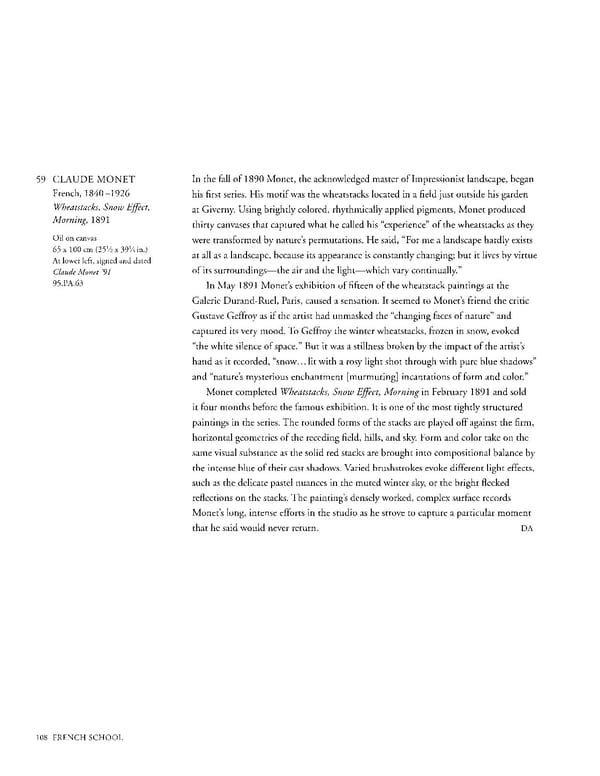59 CLAUDE MONET In the fall of 1890 Monet, the acknowledged master of Impressionist landscape, began French, 1840-1926 his first series. His motif was the wheatstacks located in a field just outside his garden Wheatstacks, Snow Effect, at Giverny. Using brightly colored, rhythmically applied pigments, Monet produced Morning, 1891 thirty canvases that captured what he called his "experience" of the wheatstacks as they Oil on canvas were transformed by nature's permutations. He said, "For me a landscape hardly exists 65 x 100 cm (25½ x 39¼ in.) at all as a landscape, because its appearance is constantly changing; but it lives by virtue At lower left, signed and dated Claude Monet '91 of its surroundings—the air and the light—which vary continually." 95.PA.63 In May 1891 Monet's exhibition of fifteen of the wheatstack paintings at the Galerie Durand-Ruel, Paris, caused a sensation. It seemed to Monet's friend the critic Gustave Geffroy as if the artist had unmasked the "changing faces of nature" and captured its very mood. To Geffroy the winter wheatstacks, frozen in snow, evoked "the white silence of space." But it was a stillness broken by the impact of the artist's hand as it recorded, "snow... lit with a rosy light shot through with pure blue shadows" and "nature's mysterious enchantment [murmuring] incantations of form and color." Monet completed Wheatstacks, Snow Effect, Morning in February 1891 and sold it four months before the famous exhibition. It is one of the most tightly structured paintings in the series. The rounded forms of the stacks are played off against the firm, horizontal geometries of the receding field, hills, and sky. Form and color take on the same visual substance as the solid red stacks are brought into compositional balance by the intense blue of their cast shadows. Varied brushstrokes evoke different light effects, such as the delicate pastel nuances in the muted winter sky, or the bright flecked reflections on the stacks. The painting's densely worked, complex surface records Monet's long, intense efforts in the studio as he strove to capture a particular moment that he said would never return. DA 108 FRENCH SCHOOL
 Masterpieces of the Getty Museum: Paintings Page 108 Page 110
Masterpieces of the Getty Museum: Paintings Page 108 Page 110